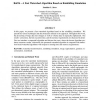Free Online Productivity Tools
i2Speak
i2Symbol
i2OCR
iTex2Img
iWeb2Print
iWeb2Shot
i2Type
iPdf2Split
iPdf2Merge
i2Bopomofo
i2Arabic
i2Style
i2Image
i2PDF
iLatex2Rtf
Sci2ools
WSCG
2000
2000
RaFSi - A Fast Watershed Algorithm Based on Rainfalling Simulation
In this paper, we present a fast watershed algorithm based on the rainfalling simulation. We present the various techniques and data structures utilized in our approach. Throughout this work, the processing of large data sets (images as well as volume data) is especially emphasized. The results' correctness, the fast execution time, and the memory requirements are discussed in detail. First we introduce a sequential algorithm and discuss the cases, where the known algorithm produces erroneous results. Afterwards, the presented watershed algorithm is compared with immersion based watershed algorithms with respect to running time and memory requirements.
| Added | 01 Nov 2010 |
| Updated | 01 Nov 2010 |
| Type | Conference |
| Year | 2000 |
| Where | WSCG |
| Authors | Stanislav L. Stoev |
Comments (0)

